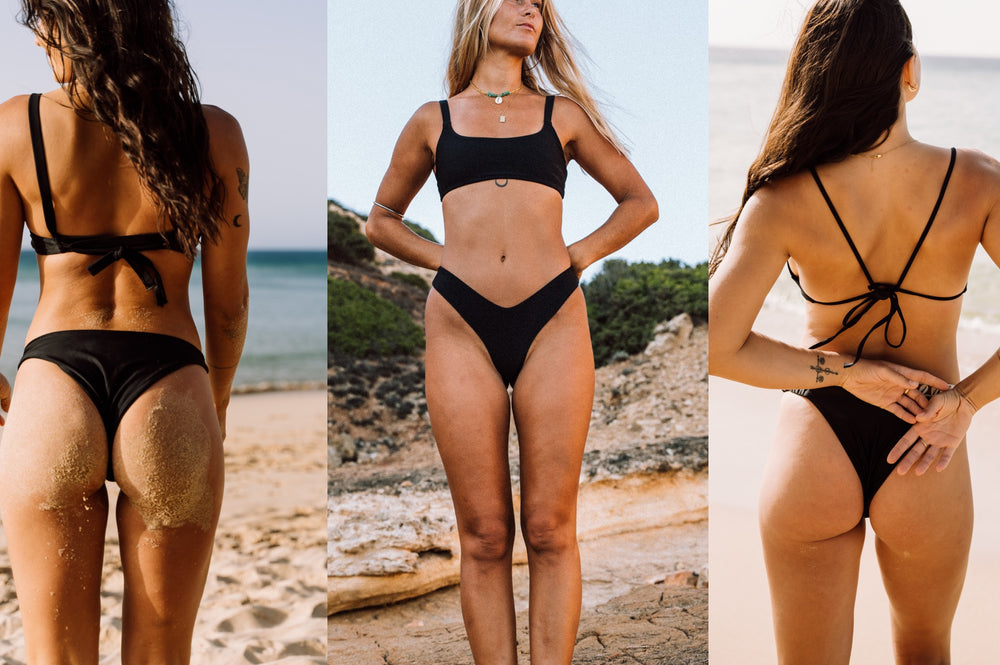
Fair fashion: what makes bikinis sustainable?
What is sustainable fashion or fair fashion? The term "sustainability" is a buzzword, and not protected: vegan, fair, ethical, or conscious fashion? It's difficult for consumers to understand what a fair fashion label is.
We at Tias & Olives are not yet a fully sustainable Swiss bikini brand, but we're on our way. Unfortunately, we sometimes feel compelled to include the word "sustainable" in our communication because every other brand calls itself a "sustainable" for marketing reasons. We want to put an end to this from our side and answer the question what makes swimwear truly sustainable:
What is sustainable fashion?
Sustainable fashion - also known as fair fashion, eco fashion, sustainable fashion, green fashion, organic fashion or eco fashion - refers to clothing and accessories produced without harming people or the environment. Specifically, this means
- Organic, environmental-friendly materials
- Resource-efficient production (e.g., energy, water, CO2)
- Fair working conditions (fair wages, health and safety, no child labor, social security)
- Sustainable business model - something we consider essential
- Recycling and upcycling
We want to explain you now what a fair fashion label is when looking at bikini or swimwear brands:
1. Fair fashion: environmentally friendly materials
Only natural and biodegradable materials should be used wherever possible when producing fair and sustainable bikinis and swimwear. This ensures that groundwater is not polluted during production. Manufacturers should consciously avoid the use of pesticides, chemical fertilizers, and insecticides. Yes, many brands use Econyl - a yarn that can be recycled over and over again. However, recycled nylon still releases microplastics into water when washed in the washing machine. Some brands have started using natural textiles. For example, Yulex or hemp. Hemp is a natural, breathable fiber. Growing hemp enriches the soil and uses much less water.

The technologies for separating elastane from polyamide, i.e., chemical recycling, still need to be fully developed. As a result, recycling our products made of Econyl is not possible. However, we are actively pursuing the development and hope to offer a fully sustainable solution in the future.
But production is not the end of the story. Every label or packaging - from the factory to the customer - should be made from environmentally friendly materials. Stickers, leaflets and more. For swimwear, it is still common practice for many manufacturers to as an example ship each bikini top and bottom individually wrapped in plastic.
2. Fair fashion: resource-efficient production
The waste of raw materials is one of the biggest problems of our time. Short supply chains, low water and energy consumption, and rapidly renewable raw materials all play a role. This begs the question - can bikinis and swimsuits made ind China be sustainable? If you want sustainable bikinis, look for local European production. The supply chain should be as regional as possible to avoid long transport routes and save CO2.

3. Fair fashion: good working conditions and fair trade
Sustainable swimwear and fair fashion are not only about the environment but also about people. In addition to fair trade, it's about fair prices for raw materials, no child labor, good working conditions, fair wages and safety for workers. It's important to have a transparent communication about production and working conditions.

4. Fair fashion: sustainable fashion - the business model
A significant problem for fair fashion or sustainable bikinis is often the companies' business model. Fast fashion cycles and overconsumption are seen as the leading causes of the problem.
Is it sustainable to launch a new bikini collection three times a year? In particular, the big brands that launch new collections at short intervals and then discontinue can't be called sustainable - even though they use "recycled fabrics". The cycle of overproduction continues. Unfortunately, the fashion industry still often overproduces to keep production costs down. If you sell only part of it at the regular price and dispose the rest, your profit is still higher. This is called fast fashion.

The business model also includes social and environmental projects. In addition to complete transparency, fair fashion brands set an example by getting involved in social and environmental projects. There are no good or bad projects - but the reach should be used to support good causes.
5. Fair fashion: recycling and upcycling
Old clothes and fabrics can often be made into something new. More and more fair fashion brands are focusing on upcycling and creating something new out of discarded clothing. For example, a pair of jeans can be turned into a dress. Because of the unique fabrics, this isn't always easy with swimsuits and bikinis. But one principle that would work well would be to use deadstock fabrics - fabrics that are left over from other swimwear or fashion brands and don't need to be specially made. We have been looking for deadstock fabrics for quite some time. Unfortunately, raw materials are scarce in the swimwear industry, and it's hard to find fabrics leftovers in our industry.
What makes Tías & Olives a sustainable or better ethical Swiss bikini? We're completely transparent about where we think we are already contributing and where we see more room for improvement.
Here are more links on fair fashion and sustainable swimwear:
- Sustainability pioneer MyMarini has published a sustainability report
- Nuvonda - Swiss online shop for sustainable fashion
- NZZ article about buying sustainable swimwear
- WWF article about sustainable fashion
XoXo
Sibylle & Carmen








